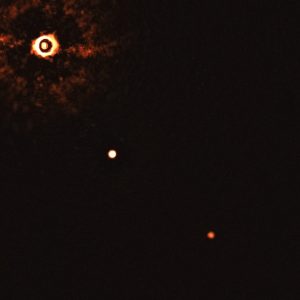In our exploration of the vast Universe, the discovery of an exoplanet is always an exciting one!
We are lucky enough to be somewhat acquainted with the other 7 planets in our Solar System but beyond our solar shores there are thousands of other planets orbiting other suns, in other galaxies. These planets are called Exoplanets – the term used for a planet orbiting a sun beyond our Solar System. There are currently more that 4000 confirmed exoplanets in our Universe but that’s just what we have been able to discover so far!
Introducing Two Giant Exoplanets
Meet TYC 8998-760-1 b and TYC 8998-760-1 c, two such exoplanets discovered orbiting the sunlike star TYC 8998-760-1 earlier this year. These are their first images captured by an international team of scientists led by Alexander J. Bohn of Leiden University in the Netherlands and were captured at the European Southern Observatory in Chile. #darkskies
They are both gas giants with Planet b around 14 times the largest planet in our own system and c, around 6 times the mass. In order to capture their light, the researchers blocked the most intense light coming from the system’s star in order to capture the fainter light coming from the exoplanets. This created the bright ring around the star’s image.
What makes this discovery all the more most exciting is that this is the first multi-planet system to be directly imaged around a sun-like star. TYC 8998-760-1 is meandering in space at a whopping 300 light years from planet Earth. One light year measured as the distance a ray of light would travel in one year, or around 6 trillion miles. The distances are mind-boggling. So the image we see captured below is actually from 300 years ago – how’s that for a window on the past?

This image, captured by the SPHERE instrument on ESO’s Very Large Telescope, shows the star TYC 8998-760-1 accompanied by two giant exoplanets. This is the first time astronomers have directly observed more than one planet orbiting a star similar to the Sun. The image was captured by blocking the light from the young, Sun-like star (on the top left corner) using a coronagraph, which allows for the fainter planets to be detected. The bright and dark rings we see on the star’s image are optical artefacts. The two planets are visible as two bright dots in the centre and bottom right of the frame.
Source: NASA
Coming soon: The Hunt for THE Exoplanet.










